Development of Self-Cured Sustainable Concrete Using Local Water-Entrainment Aggregates of Vesicular Basalt
Abstract
1. Introduction
2. Experimental Methodology
2.1. Materials and Concrete Mixture
2.1.1. Concrete Ingredients
2.1.2. Water-Entrainment Aggregates for Self-Curing (Vesicular Basalt)
2.1.3. Curing Compound for Membrane Curing
2.1.4. Concrete Composition and Concrete Workability
2.2. Test Set-Ups
2.2.1. Concrete Compressive Strength
2.2.2. Concrete Durability Properties
Water Sorptivity (Permeability under Capillary Action) Test
Water Permeability under Pressure Test
Brunauer–Emmett–Teller (BET) Surface Area and Pore Size Test
3. Results and Discussion
3.1. Concrete Mechanical Properties
3.2. Concrete Durability Properties
3.3. Micro-Structure Characterization
3.4. Present Study Limitations and Recommendations for Future Work
4. Conclusions
- Concrete strength and rate of strength development of the self-cured concrete were enhanced due to improvement in the cement hydration process. This may be attributed to variable loss of water or water availability under self-curing condition. The self-curing method provides better performance of concrete having lower water–cement ratio and lower concrete surface-volume ratio. An increase of up to 10 % in compressive strength of self-cured concrete was observed over the conventionally cured concrete.
- More uniform hydration products were observed in self-curing concrete, as compared to water curing concrete, because of continuous availability of water during the cement hydration process by the addition of water-entrainment aggregates.
- The addition of water-entrainment aggregates results in a finer pore structure of concrete. The size of pores was reduced from 23.94 A0, in conventionally cured concrete, to 23.87 A0, in self-cured concrete. An increase of 10% in the solid surface area of the self-cured concrete was observed over the conventionally cured concrete.
- The addition of water-entrainment aggregates in the concrete improves the water transport mechanism. The sorptivity coefficient of concrete was increased by the addition of water-entrainment aggregates.
- The self-cured concrete, having locally available water-entrainment aggregates of vesicular basalt and higher strength and durability, satisfies the socio-economic and environmental aspects of sustainability, as it results in proper resource utilization, improvement of quality of life (long life, lower CO2 emission and material wastage), reduction in costs (less water usage and maintenance) and increased economic activity in society for concrete production.
Supplementary Materials
Author Contributions
Funding
Institutional Review Board Statement
Informed Consent Statement
Acknowledgments
Conflicts of Interest
References
- Wasiu, J.; Oyebode, O.J.; Adebayo, V.B. Causes of Building Collapse and Prevention in Nigeria. In Proceedings of the Nigerian Institute of Civil Engineers (NICE) 11th International Conference & Annual General Meeting, Lagos, Nigeria, 27–30 May 2014. [Google Scholar]
- Bentz, D.P.; Davis, J.M.; Peltz, M.A.; Snyder, K.A. Influence of self-curing and viscosity modifiers on resistance to sulfate attack. Mater. Struct. 2014, 47, 581–589. [Google Scholar] [CrossRef]
- Hasholt, M.T.; Jensen, O.M. Chloride migration in concrete with superabsorbent polymers. Cem. Concr. Compos. 2015, 55, 290–297. [Google Scholar] [CrossRef]
- Beyene, M.A.; Munoz, J.F.; Meininger, R.C.; De Bella, C. Effect of Internal Curing as Mitigation to Minimize Alkali-Silica Reaction Damage. ACI Mater. J. 2017, 114, 417–428. [Google Scholar] [CrossRef]
- Nduka, D.O.; Ameh, J.O.; Joshua, O.; Ojelabi, R. Awareness and benefits of Internal curing concrete in construction projects: Builders and Civil Engineers Perceptions. Buildings 2018, 8, 109. [Google Scholar] [CrossRef]
- Roberts, J.; Butcher, R.; Jones, B.; Kalafat, M.; Vaughn, R. History and Evolution of Internal Curing: Case Studies. In ACI SP-290, The Economics, Performance, and Sustainability of Internally Cured Concrete; Schlinder, A.K., Grygar, J.G., Weiss, W.J., Eds.; American Concrete Institute: Indianapolis, IN, USA, 2012; p. 12. [Google Scholar]
- Yang, L.; Shi, C.; Liu, J.; Wu, Z. Factors affecting the effectiveness of Internal curing: A review. Constr. Build. Mater. 2021, 267, 121017. [Google Scholar] [CrossRef]
- Bentz, D.P.; Lura, P.; Roberts, J.W. Mixture Proportioning for Internal Curing. Concr. Int. 2005, 27, 35–40. [Google Scholar]
- Schlitter, J.L.; Henkensiefken, R.; Castro, J.; Raoufi, K.; Weiss, W.J.; Nantung, T. Development of Internally Cured Concrete for Increased Service Life; Publication No. FHWA/IN/JTRP-2010/10, SPR-3211; Joint Transportation Research Program; Purdue University: West Lafayette, IN, USA, 2010. [Google Scholar]
- Tapali, J.G.; Demis, S.; Papadakis, V.G. Sustainable concrete mix design for a target strength and service life. Comput. Concr. 2013, 12, 755–774. [Google Scholar] [CrossRef]
- Müller, H.S.; Breinera, R.; Moffatta, J.S.; Haista, M. Design and properties of sustainable concrete. Procedia Eng. 2014, 95, 290–304. [Google Scholar] [CrossRef]
- Mohamed, O.A. Effect of Mix Constituents and Curing Conditions on Compressive Strength of Sustainable Self-Consolidating Concrete. Sustainability 2019, 11, 2094. [Google Scholar] [CrossRef]
- Rajhans, P.; Chand, G.; Kisku, N.; Panda, S.K.; Nayak, S. Proposed mix design method for producing sustainable self-compacting heat cured recycled aggregate concrete and its microstructural investigation. Constr. Build. Mater. 2019, 218, 568–581. [Google Scholar] [CrossRef]
- ESCSI. ESCSI Guide Specifications for Internally Cured Concrete, Expanded Shale, Clay or Slate Institute; Information Sheet 4001.1, January 2012; ESCSI: Chicago, IL, USA, 2012. [Google Scholar]
- ASTM C1761/C1761M-17. Standard Specification for Lightweight Aggregate for Internal Curing of Concrete; ASTM International: West Conshohocken, PA, USA, 2017. [Google Scholar]
- Weiss, W.J.; Montanari, L. Guide Specification for Internally Curing Concrete, National Concrete Pavement Technology Center; Iowa State University: Ames, IA, USA, 2017; 40p. [Google Scholar]
- Byard, B.E.; Ries, J. Optimizing the Sustainability of Concrete Through Internal Curing, in ACI SP-290. In The Economics, Performance, and Sustainability of Internally Cured Concrete; Schlinder, A.K., Grygar, J.G., Weiss, W.J., Eds.; American Concrete Institute: Indianapolis, IN, USA, 2012; p. 10. [Google Scholar]
- Liu, J.; Shi, C.; Ma, X.; Khayat, K.H.; Zhang, J.; Wang, D. An Overview of the Effect of Internal Curing on Shrinkage of High Performance Cement-Based Materials. Constr. Build. Mater. 2017, 146, 702–712. [Google Scholar] [CrossRef]
- Weiss, W.J.; Morian, D. A Review of Internally Cured Concrete as It Relates to Pavements. In Proceedings of the Transportation Research Board 96th Annual Meeting, Washington, DC, USA, 8–12 January 2017. [Google Scholar]
- Cusson, D.; Lounis, Z.; Daigle, L. Benefits of Internal curing on service life and life-cycle cost of high-performance concrete bridge decks—A case study. Cem. Concr. Compos. 2010, 32, 339–350. [Google Scholar] [CrossRef]
- Vosoughi, P.; Tritsch, S.; Ceylan, H.; Taylor, P. Lifecycle Cost Analysis of Internally Cured Jointed Plain Concrete Pavement; National Concrete Pavement Technology Center; Iowa State University: Ames, IA, USA, 2017. [Google Scholar]
- Tia, M.; Subgranon, T.; Kim, K.; Rodriguez, A.M.; Algazlan, A. Internally Cured Concrete for Pavement and Bridge Deck Applications; FDOT Project Report No. BDV31-977—11 July 2015; College of Engineering, University of Florida: Gainesville, FL, USA, 2015; pp. 32611–36580. [Google Scholar]
- Daghighi, A. Full-Scale Field Implementation of Internally Cured Concrete Pavement Data Analysis for Iowa Pavement Systems. Master’s Thesis, Iowa State University, Ames, IA, USA, 2020. [Google Scholar]
- Ahmed, M.; Mallick, J.; AlQadhi, S.; Ben Kahla, N. Development of Concrete Mixture Design Process Using MCDM Approach for Sustainable Concrete Quality Management. Sustainability 2020, 12, 8110. [Google Scholar] [CrossRef]
- Johansen, N.A.; Millard, M.J.; Mezencevova, A.; Garas, V.Y.; Kurtis, K.E. New Method for Determination of Absorption Capacity of Internal Curing Agents. Cem. Concr. Res. 2009, 39, 65–68. [Google Scholar] [CrossRef]
- Zhutovsky, S.; Kovler, K.; Bentur, A. Assessment of Water Migration Distance in Internal Curing of High-Strength Concrete. In ACI SP-220 Autogenous Deformation of Concrete; Jensen, O.M., Bentz, D.P., Lura, P., Eds.; American Concrete Institute: Farmington Hills, MI, USA, 2004; pp. 181–198. [Google Scholar]
- Ackay, B.; Tasdemir, M.A. Effects of Distribution of Lightweight Aggregates on Internal Curing of Concrete. Cem. Concrete Composites 2010, 32, 611–616. [Google Scholar]
- Bello, L.; Garcia-Diaz, E.; Rougeau, P. An Original Test Method to Assess Water Absorption/Desorption of Lightweight Aggregates in Presence of Cement Paste. Constr. Build. Mater. 2017, 154, 752–762. [Google Scholar] [CrossRef]
- Mousa, M.I.; Mahdy, M.G.; Abdel-Reheem, A.H.; Yehia, A.Z. Physical properties of self-curing concrete (SCUC). HBRC J. 2015, 11, 167–175. [Google Scholar] [CrossRef]
- Sun, X.; Zhang, B.; Dai, Q.; Yu, X. Investigation of Internal curing effects on microstructure and permeability of interface transition zones in cement mortar with SEM imaging, transport simulation and hydration modeling techniques. Constr. Build. Mater. 2015, 76, 366–379. [Google Scholar] [CrossRef]
- Paul, A.; Murgadas, S.; Delpiano, J.; Moreno-Casas, P.A.; Walczak, M.; Lopez, M. The role of moisture transport mechanisms on the performance of lightweight aggregates in Internal curing. Constr. Build. Mater. 2021, 268, 121191. [Google Scholar] [CrossRef]
- Jensen, O.M.; Hansen, P.F. Water-entrained cement-based materials II. Experimental observations. Cem. Concr. Res. 2002, 32, 973–978. [Google Scholar] [CrossRef]
- Gupta, S.; Kua, H.W. Effect of Water Entrainment by Pre-Soaked Biochar Particles on Strength and Permeability of Cement Mortar. Constr. Build. Mater. 2018, 159, 107–125. [Google Scholar] [CrossRef]
- Memon, R.P.; Rahman, A.; Awang, A.Z.; Huseien, G.F.; Memon, U. A Review: Mechanism, Materials and Properties of Self-Curing Concrete. ARPN J. Eng. Appl. Sci. 2018, 13, 9304–9397. [Google Scholar]
- Mechtcherine, V.; Reinhardt, H.W. Application of Superabsorbent Polymers (SAP) in Concrete Construction, State-of-the-Art Report Prepared by Technical Committee 225-SAP; Springer: Berlin/Heidelberg, Germany, 2012. [Google Scholar]
- Zou, D.; Zhang, H.; Wang, Y.; Zhu, J.; Guan, X. Internal curing of mortar with low water to cementitious materials ratio using a normal weight porous aggregate. Constr. Build. Mater. 2015, 96, 209–216. [Google Scholar] [CrossRef]
- Khotbehsara, M.M.; Mohseni, E.; Ozbakkaloglu, T.; Ranjbar, M.M. Durability characteristics of self-compacting concrete incorporating pumice and metakaolin. J. Mater. Civ. Eng. 2017, 29, 04017218. [Google Scholar] [CrossRef]
- Grabiec, A.M.; Zawal, D.; Rasaq, W.A. The Effect of Curing Conditions on Selected Properties of Recycled Aggregate Concrete. Appl. Sci. 2020, 10, 4441. [Google Scholar] [CrossRef]
- Suzuki, M.; Meddah, M.S.; Sato, R. Use of porous ceramic waste aggregates for self-curing of high performance concrete. Cem. Concr. Res. 2009, 39, 373–381. [Google Scholar] [CrossRef]
- Lura, P.; Wyrzykowski, M.; Tang, C.; Lehmann, E. Internal curing with lightweight aggregate produced from biomass-derived waste. Cem. Concrete Res. 2014, 59, 24–33. [Google Scholar] [CrossRef]
- Mousa, M.I.; Mahdy, M.G.; Abdel-Reheem, A.H.; Yehia, A.Z. Internal curing concrete types: Water retention and durability. Alex. Eng. J. 2015, 54, 565–575. [Google Scholar] [CrossRef]
- Ghourchian, S.; Wyrzykowski, M.; Lura, P.; Shekarchi, M.; Ahmadi, B. An investigation on the use of Zeolite aggregates for Internal curing of concrete. Constr. Build. Mater. 2013, 40, 135–144. [Google Scholar] [CrossRef]
- Zadeh, V.Z.; Bobko, C.P. Nano-mechanical properties of internally cured kenaf fiber reinforced concrete using nanoindentation. Cem. Concr. Compos. 2014, 52, 9–17. [Google Scholar] [CrossRef]
- Chand, M.S.R.; Giri, P.S.N.R.; Kumar, G.R.; Kumar, P.R. Paraffin wax as an self-curing agent in ordinary concrete. Mag. Concr. Res. 2015, 67, 82–88. [Google Scholar] [CrossRef]
- Kang, S.; Hong, S.; Moon, J. Shrinkage characteristics of heat-treated ultra-high-performance concrete and its mitigation using superabsorbent polymer based Internal curing method. Cem. Concrete Compos. 2018, 89, 130–138. [Google Scholar] [CrossRef]
- Davila-Pompermayer, R.; Lopez-Yepez, L.G.; Valdez-Tamez, P.; Juarez, C.A.; Duran-Herrera, A. Lechugilla natural fiber as Internal curing agent in self compacting concrete (SCC): Mechanical properties, shrinkage and durability. Cem. Concr. Compos. 2020, 112, 103686. [Google Scholar] [CrossRef]
- Lura, P.; Kovler, K. Materials and methods for self-curing. In Internal Curing of Concrete—State-of-the Art Report of RILEM Technical Committee 196-ICC; Report 041; Konstantin Kovler, O.M.J., Ed.; Deptartment of Civil Engineering, Technical University of Denmark: Lyngby, Denmark, 2007. [Google Scholar]
- Francis, S.J.; Karthik, B.; Gokulram, H. Flexural behavior of Internal curing concrete with lightweight aggregate and polyethylene glycol. Int. J. Eng. Trends Technol. 2017, 47, 71–77. [Google Scholar] [CrossRef]
- Rashwan, M.M.; Diab, H.M.; El-fattah, Y.M.A. Improving of lightweight Internal curing concrete properties. J. Eng. Sci. Assiut Univ. 2016, 44, 259–271. [Google Scholar]
- Revalthy, V.; Lakashimi, C.J.G. Experimental Study on Internal Curing Concrete with Fly Ash and Quarry Dust. Available online: http://www.internationaljournalssrg.org/uploads/specialissuepdf/ICRTCETM/2017/CE/IJCE-ICRTCETM-P132.pdf (accessed on 12 August 2020).
- Rößler, C.; Bui, D.D.; Ludwig, H.M. Rice husk ash as both pozzolanic admixture and Internal curing agent in ultra-high-performance concrete. Cem. Concr. Compos. 2014, 53, 270–278. [Google Scholar]
- Balapour, M.; Zhao, W.; Garboczi, E.J.; Oo, N.Y.; Spatari, S.; Hsuan, Y.G.; Billen, P.; Farnam, Y. Potential use of lightweight aggregate (LWA) produced from bottom coal ash for Internal curing of concrete systems. Cem. Concr. Compos. 2019, 105, 103428. [Google Scholar] [CrossRef]
- Liu, F.; Wang, J.; Qian, X.; Hollingsworth, J. Internal Curing of High Performance Concrete Using Cenospheres. Cem. Concr. Res. 2017, 95, 39–46. [Google Scholar] [CrossRef]
- Nowasell, Q.C.; Kevern, J.T. Using Drinking Water Treatment Waste as a Low-Cost Internal Curing Agent for Concrete. ACI Mater. J. 2015, 112, 69–78. [Google Scholar]
- Hanif, A.; Kim, Y.; Usman, M.; Park, C. Optimization of steam-curing regime for recycled aggregate concrete incorporating high early strength cement—A parametric study. Materials 2018, 11, 2487. [Google Scholar] [CrossRef]
- Shannag, M.J.; Charif, A.H.; Dghaither, S. Developing Structural Lightweight Concrete Using Volcanic Scoria Available in Saudi Arabia. Arab. J. Sci. Eng. 2014, 39, 3525–3534. [Google Scholar]
- De la Varga, I.D.; Spragg, R.P.; Bella, C.D.; Castro, J.; Bentz, D.P.; Weiss, J. Fluid transport in high volume fly ash mixtures with and without Internal curing. Cem. Concr. Compos. 2014, 45, 102–110. [Google Scholar] [CrossRef]
- Zhang, J.; Han, Y.; Zhang, J. Evaluation of Shrinkage Induced Cracking in Concrete with Impact of Internal Curing and Water to Cement Ratio. J. Adv. Concr. Technol. 2016, 14, 324–334. [Google Scholar] [CrossRef]
- Shen, D.; Jiang, J.; Jiao, Y.; Shen, J.; Jiang, G. Early-Age Tensile Creep and Cracking Potential of Concrete Internally Cured with Pre-Wetted Lightweight Aggregate. Constr. Build. Mater. 2017, 135, 420–429. [Google Scholar] [CrossRef]
- Zang, J.; Wang, J.; Han, Y. Simulation of moisture field of concrete with pre-soaked light weight aggregate addition. Constr. Build. Mater. 2015, 96, 599–614. [Google Scholar] [CrossRef]
- Neville, A.M. Properties of Concrete, 4th ed.; John Wiley & Sons, Inc.: New York, NY, USA, 1998. [Google Scholar]
- Zhao, H.; Sun, W.; Wu, X.; Gao, B. Effect of initial water-curing period and curing condition on the properties of self-compacting concrete. Mater. Des. 2012, 35, 194–200. [Google Scholar] [CrossRef]
- ASTM C494/C494M-19. Standard Specification for Chemical Admixtures for Concrete; ASTM International: West Conshohocken, PA, USA, 2019; Available online: https://www.astm.org/Standards/C494.htm (accessed on 12 August 2020).
- Al-Harthi, A.A.; Al-Amri, R.M.; Shehata, W.M. The Porosity and Engineering Properties of Vesicular Basalt in Saudi Arabia. Eng. Geol. 1999, 54, 313–320. [Google Scholar] [CrossRef]
- ASTM C309-19. Standard Specification for Liquid Membrane-Forming Compounds for Curing Concrete; ASTM International: West Conshohocken, PA, USA, 2019; Available online: https://www.astm.org/Standards/C309.htm (accessed on 12 August 2020).
- ASTM C143/C143M-20. Standard Test Method for Slump of Hydraulic-Cement Concrete; ASTM International: West Conshohocken, PA, USA, 2020; Available online: https://www.astm.org/Standards/C143 (accessed on 12 April 2020).
- ASTM C39/C39M-20. Standard Test Method for Compressive Strength of Cylindrical Concrete Specimens; ASTM International: West Conshohocken, PA, USA, 2020; Available online: https://www.astm.org/Standards/C39.htm (accessed on 12 April 2020).
- BS EN 12390-1:2000. Testing Hardened Concrete. Compressive Strength of Test Specimens; British Standards Institute: London, UK, 2000; p. 68. [Google Scholar]
- ASTM C1585-13. Standard Test Method for Measurement of Rate of Absorption of Water by Hydraulic-Cement Concretes; ASTM International: West Conshohocken, PA, USA, 2013; Available online: https://www.astm.org/DATABASE.CART/HISTORICAL/C1585-13.htm (accessed on 12 August 2020).
- BS EN 12390-8:2009. Testing Hardened Concrete. Depth of Penetration of Water under Pressure; British Standards Institute: London, UK, 2009. [Google Scholar]
- Brunauer, S.; Emmett, P.H.; Teller, E. Adsorption of Gases in Multimolecular Layers. J. Am. Chem. Soc. 1938, 60, 309–319. [Google Scholar] [CrossRef]
- ASTM C1274—12: Standard Test Method for Advanced Ceramic Specific Surface Area by Physical Adsorption; ASTM International: West Conshohocken, PA, USA, 2020. Available online: https://www.astm.org/Standards/C1274.htm (accessed on 12 August 2020).
- Barrett, E.P.; Joyner, L.G.; Halenda, P.P. The Determination of Pore Volume and Area Distributions in Porous Substances. I. Computations from Nitrogen Isotherms. J. Am. Chem. Soc. 1951, 73, 373–380. [Google Scholar] [CrossRef]
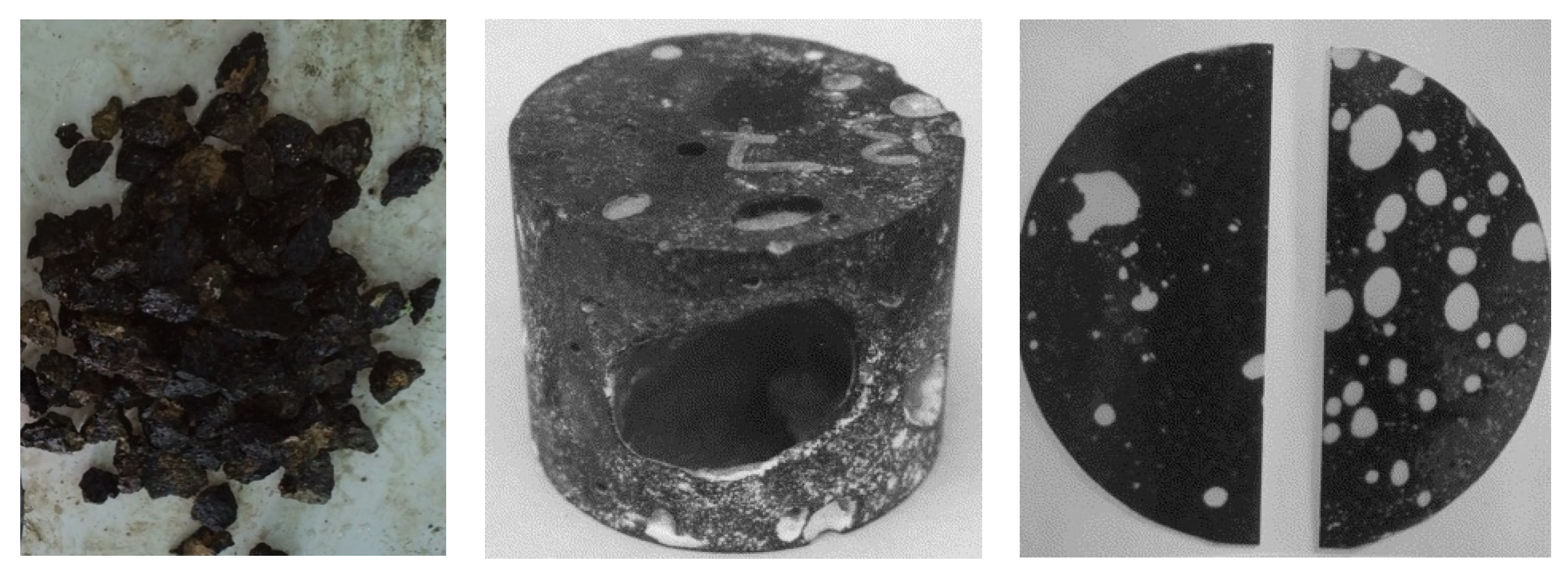
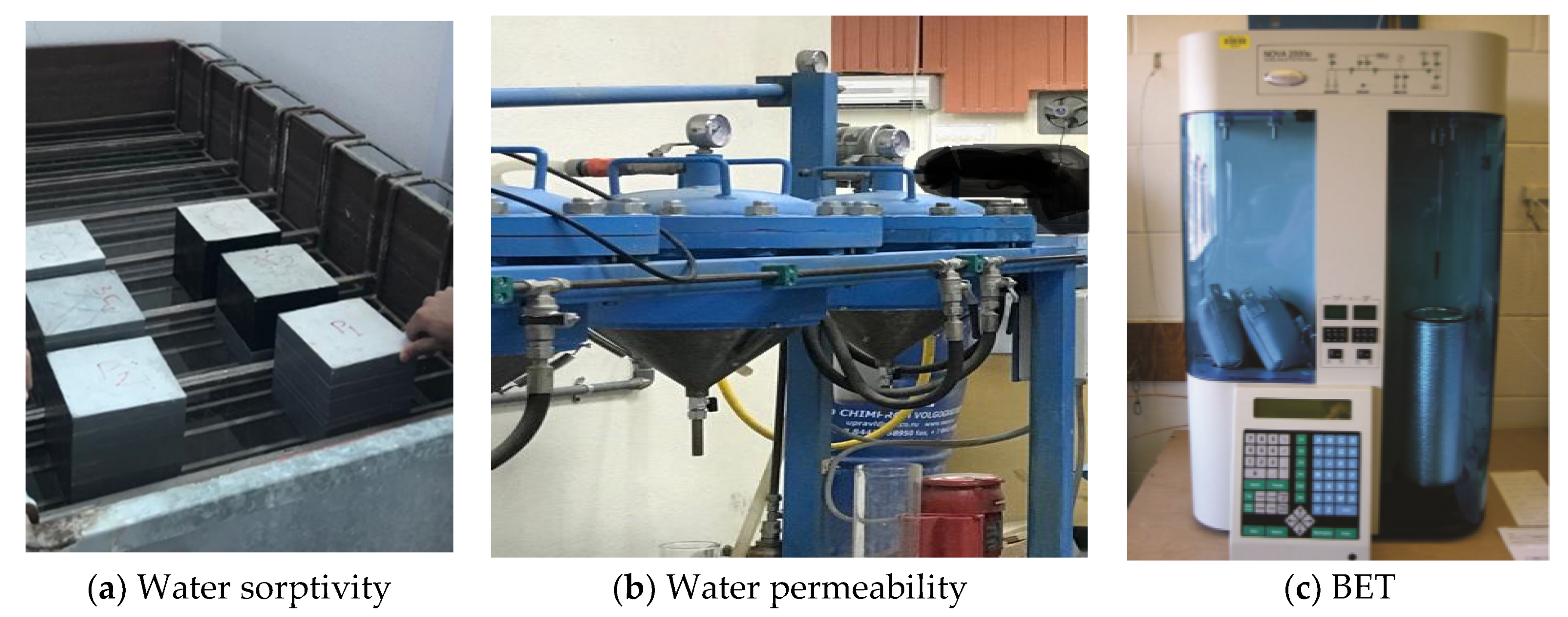
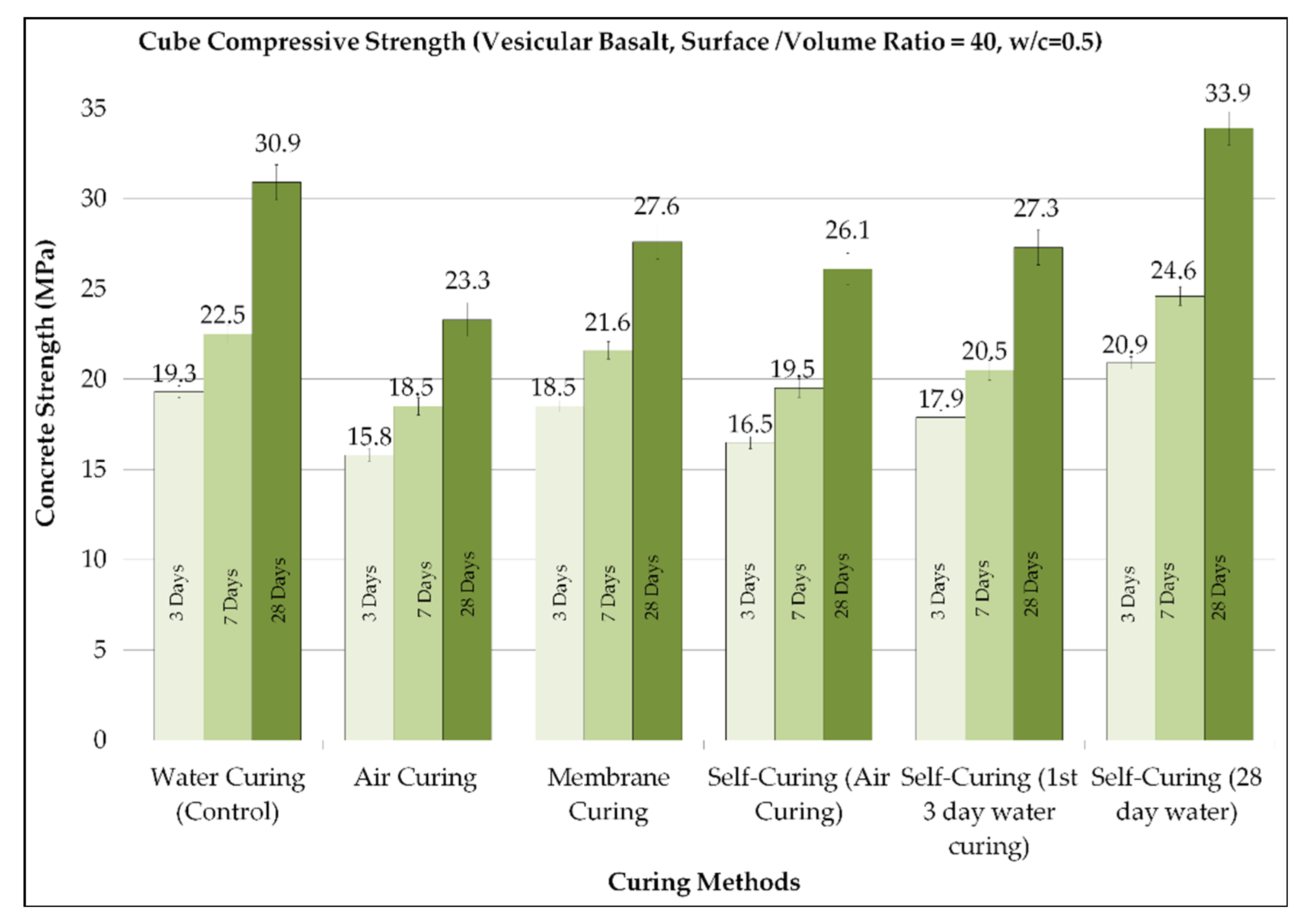

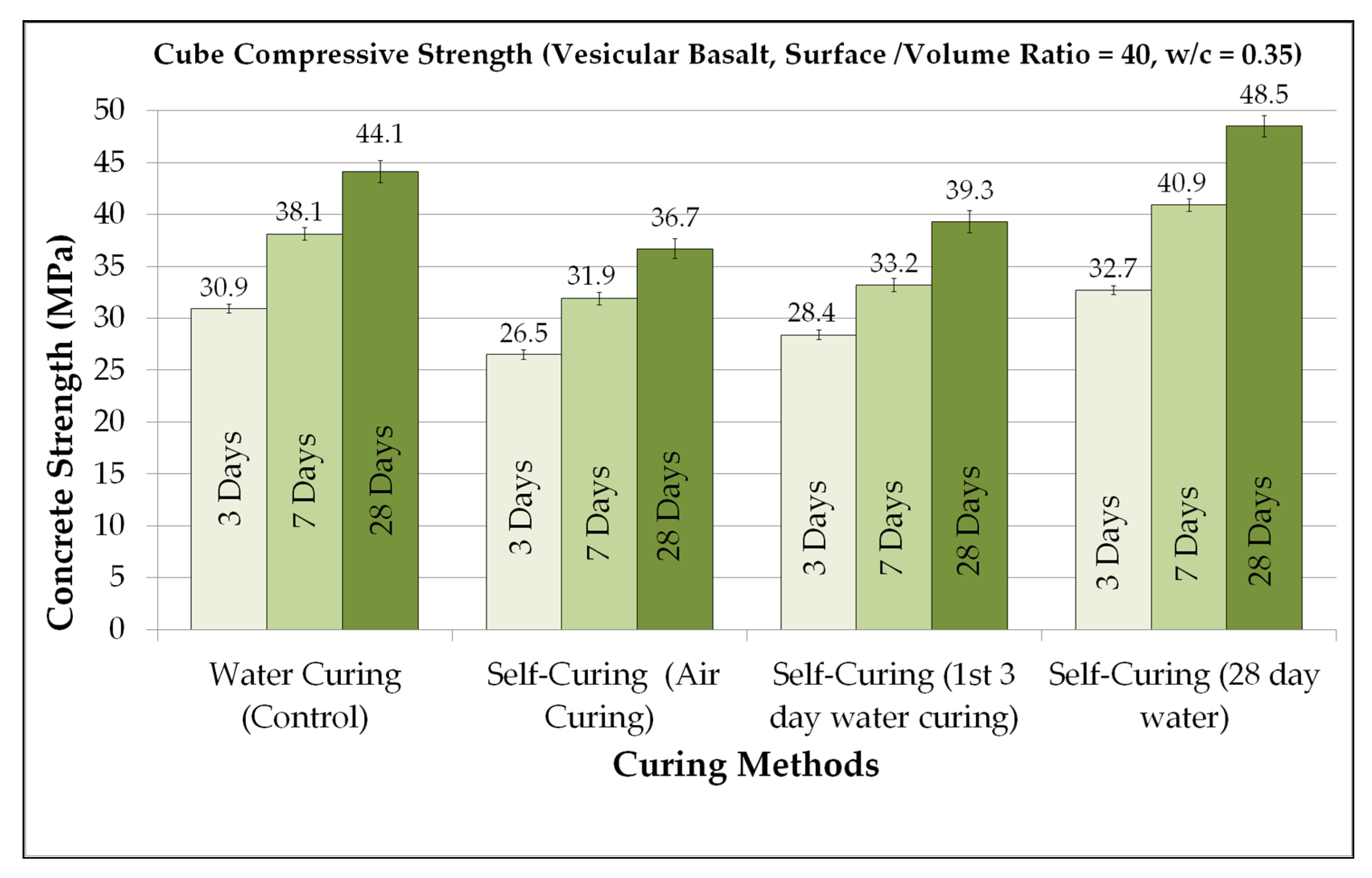
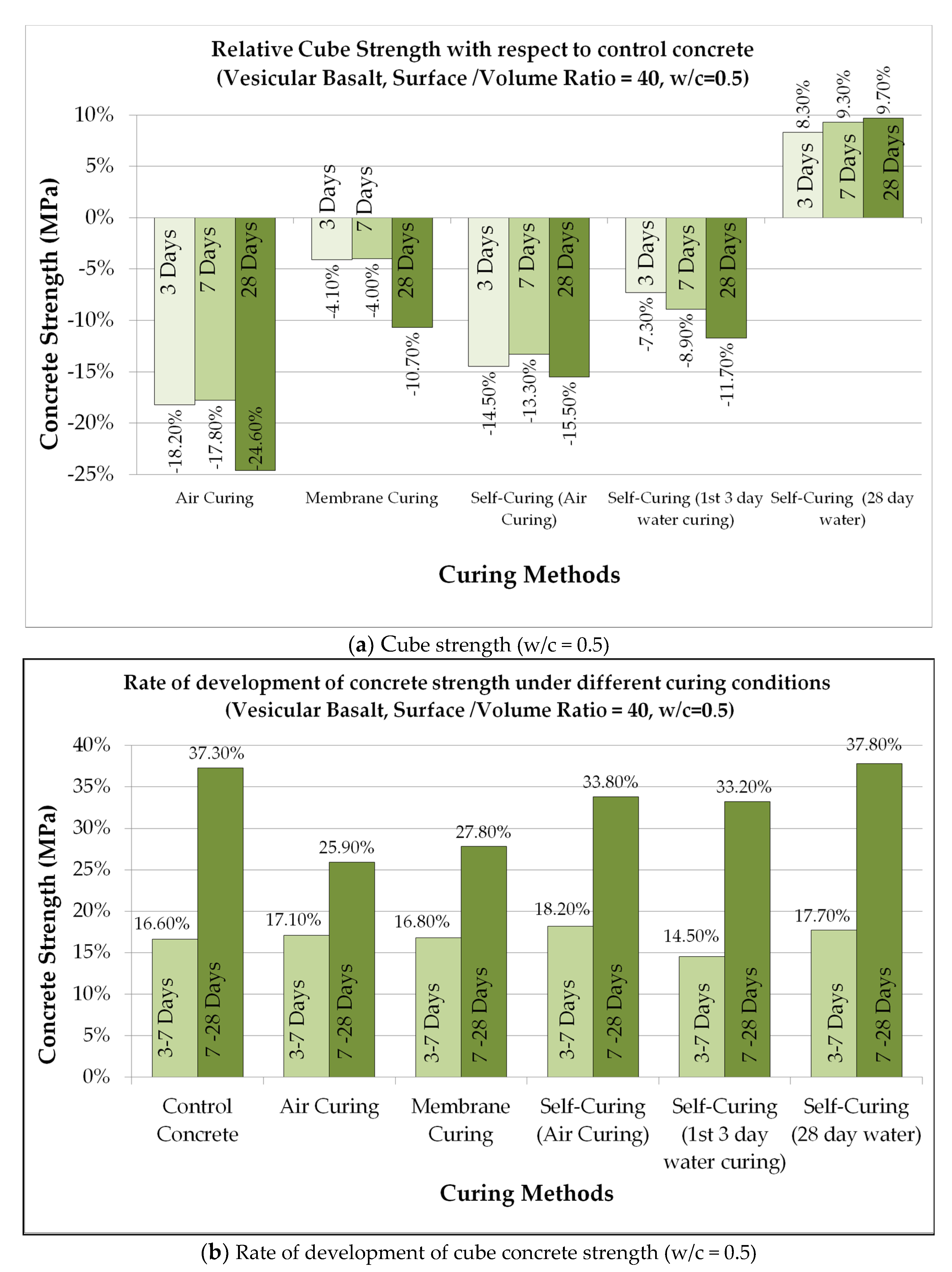

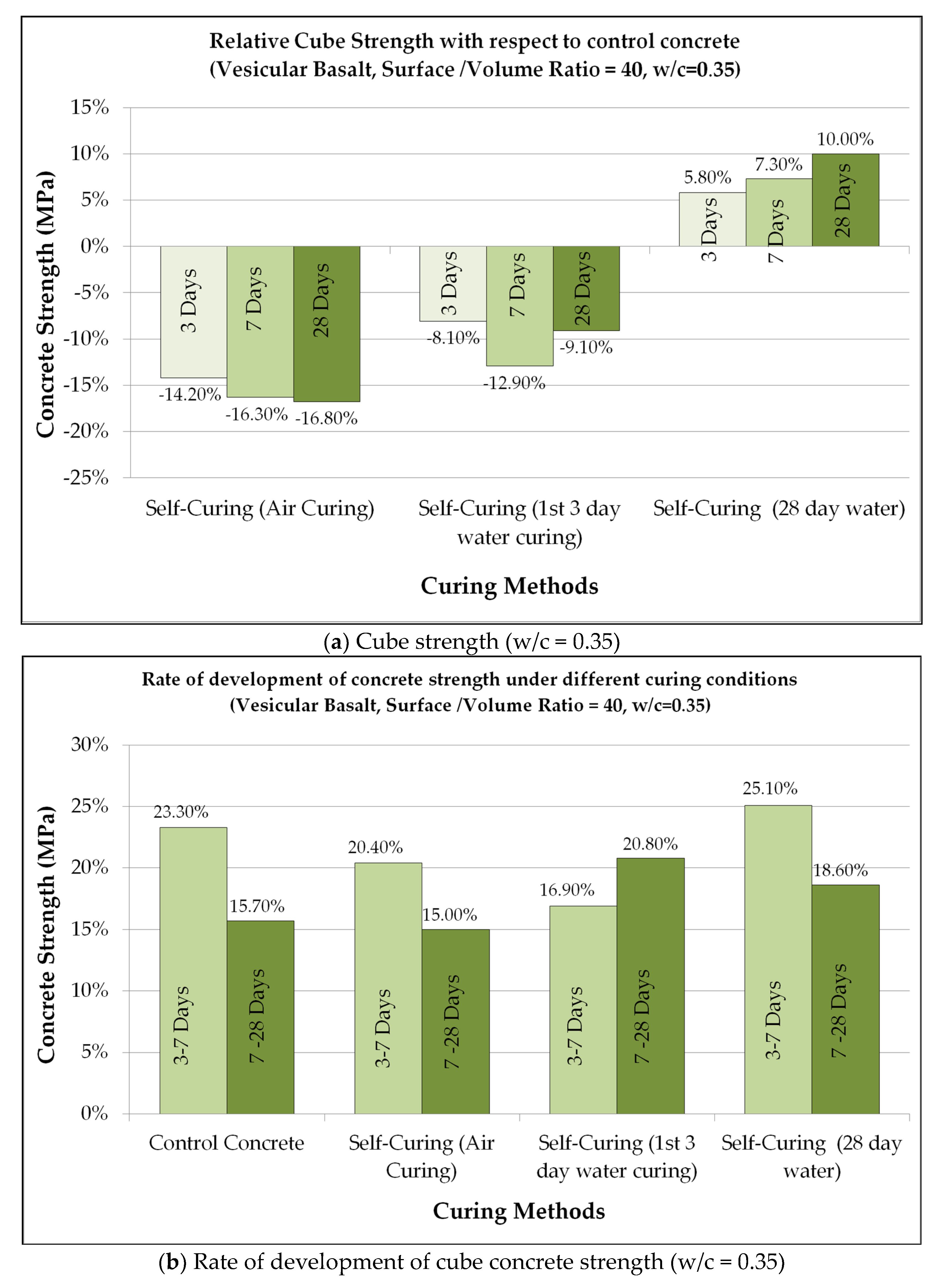

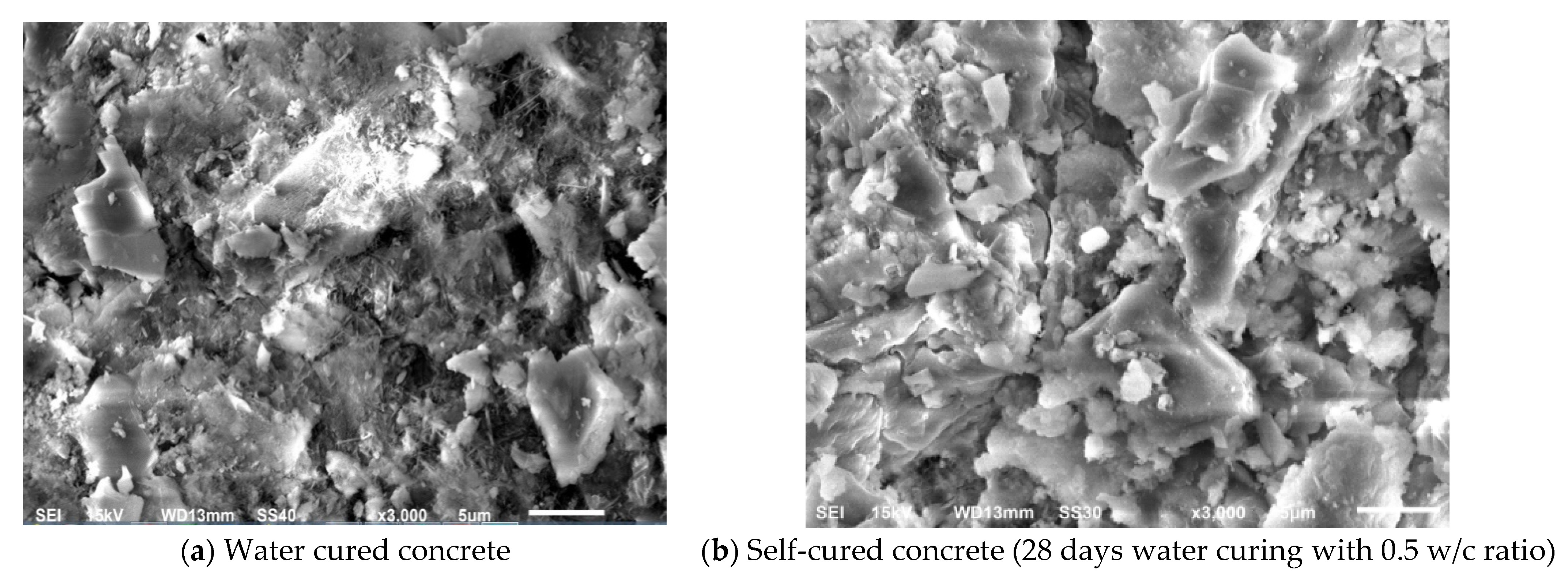
| Self-Curing Agent and Type | Study Contribution | Reference |
|---|---|---|
| Normal weight porous aggregate (natural) | Shrinkage and strength properties of mortars | Zou et al. [36] |
| Pumice light weight aggregate (natural) | Durability and micro-structural properties of self-compacting concrete (SCC) | Khotbehsara et al. [37] |
| Recycled concrete aggregate (recycled) | Eco-efficiency indexes (bi and ci), as well as the eco-durability (S-CO2) index of concrete made with normal and blast-furnace slag cement | Grabiec et al. [38] |
| Porous ceramic waste aggregates (recycled) | Shrinkage and early age cracking of concrete | Suzuki et al. [39] |
| Biomass derived waste LWA (recycled) | Pore structure, water absorption and desorption behavior of aggregates, shrinkage properties of concrete | Lura et al. [40] |
| Lightweight expanded clay aggregates (LECA) (natural) | Effect on pH, mass loss, volumetric water absorption on concrete and strength, durability properties of concrete | Mousa et al. [41] |
| Zeolite aggregates (natural) | Micro-structural, water absorption and desorption of aggregate and shrinkage, mass loss of concrete | Ghourchian et al. [42] |
| Wood derived aggregates (natural, chemical) | Interfacial transition zone, nano-mechanical properties | Zadeh and Bobko [43] |
| Paraffin wax (chemical) | Permeability and resistance to abrasion properties | Chand et al. [44] |
| Super absorbent polymers (SAP) (artificial) | Effect of heat treatment on shrinkage characteristics | Kang et al. [45] |
| Lechugilla fiber (natural) | Setting time, mechanical properties, shrinkage, durability properties | Davila-Pompermayer et al. [46] |
| Bentonite clay (natural) | Micro-structural, water absorption, shrinkage and strength properties of concrete | Lura and Kovler [47] |
| Diatomaceous earth (natural) | Micro-structural, water absorption, shrinkage and strength properties of concrete | Lura and Kovler [47] |
| Perlite (natural) | Micro-structural, water absorption, shrinkage and strength properties of concrete | Lura and Kovler [47] |
| Polyethylene-glycol (artificial) | Mechanical properties of concrete | Francis et al. [48] |
| Crushed over burnt clay bricks (artificial) | Mechanical properties of concrete | Rashwan et al. [49] |
| Fly ash and query dust (binary, natural) | Mechanical properties of concrete | Revalty and Lakashimi [50] |
| Rice husk ash (recycled) | Porous surface structure and pore size distribution of aggregates, portlandite content, flowability of concrete | Rößler et al. [51] |
| Coal bottom ash reactive aggregate (recycled) | Porosity, sphericity, water absorption and water desorption of aggregate | Balapour et al. [52] |
| Cenospheres (recycled) | Autogenous shrinkage and strength of mortars | Liu et al. [53] |
| Drinking water treatment waste (recycled) | Degree of hydration and strength properties of concrete | Nowasell and Kevern [54] |
| Chemical Properties | Mineral Composition/Strength | ||
|---|---|---|---|
| Constituents | Quantity (%) | Constituents/Modulus/Strength | Quantity/Value |
| SiO2 | 21.30 | C3S | 51.43% |
| Al2O3 | 4.86 | C2S | 22.27% |
| Fe2O3 | 5.79 | C3A | 3.08% |
| CaO | 63.74 | C4AF | 17.92% |
| MgO | 1.37 | Alkali as Na2O | 0.45% |
| SO3 | 1.84 | Lime silica modulus | 90.33 |
| K2O | 0.44 | Silica modulus | 2.00 |
| Na2O | 0.15 | Alumina modulus | 0.84 |
| LOI | 1.10 | Compressive strength, (3 days) | 18.51 MPa |
| Insoluble residue | 0.41 | Compressive strength, (7 days) | 23.45 MPa |
| Free CaO | 1.08 | ||
| Aggregates Type | Source | Specific Gravity | Fineness Modulus |
|---|---|---|---|
| Fine aggregate | Sandstone | 2.6 | 3.3 |
| Coarse aggregate | Basalt | 2.7 | 7.097 |
| Constituent | Fe2O3 | Al2O3 | SiO2 | LOI | CaO |
|---|---|---|---|---|---|
| Quantity (in %) | 2.110 | 0.390 | 91.030 | 4.050 | 1.500 |
| Mix Name | Cement Content (Kg/m3) | Sand (Kg/m3) | Basalt (Kg/m3) | Silica Fume (%) | Super Plasticizer (%) | Vesicular Basalt (%) | Curing Compound [70] | Water–Cement Ratio |
|---|---|---|---|---|---|---|---|---|
| Mix 1 | 504 | 755 | 1260 | - | - | - | - | 0.50 |
| Mix 2 | 445 | 755 | 1260 | 12 | 0.5 | 0 | - | 0.35 |
| Mix 3 | 504 | 755 | 1260 | - | - | - | Concure WB | 0.5 |
| Mix 4 | 504 | 755 | 1260 | 0 | 0 | 10 | - | 0.50 |
| Mix 5 | 445 | 755 | 1260 | 12 | 0.5 | 10 | - | 0.35 |
| Concrete Type/ Curing Method | Sorptivity Coefficient (S, m/√sec1) | Volume of Permeated Water [cm3] |
|---|---|---|
| Control concrete (28-day water curing) | 0.1725 | 85.6 |
| Self-curing concrete (only 1st 3-day water curing) | 0.1839 | 86.1 |
| Self-curing concrete (28-day water curing) | 0.1371 | 83.7 |
| Concrete Type/ Curing Method | Area of Surface [m2/g] | Volume of Pore [cm3/g] | Size of Pore [A] |
|---|---|---|---|
| Water curing (control concrete) | 4.768 | 1.068 × 10−2 | 23.94 |
| Self-curing concrete (28-day water curing) | 5.131 | 1.286 | 23.87 |
Publisher’s Note: MDPI stays neutral with regard to jurisdictional claims in published maps and institutional affiliations. |
© 2021 by the authors. Licensee MDPI, Basel, Switzerland. This article is an open access article distributed under the terms and conditions of the Creative Commons Attribution (CC BY) license (https://creativecommons.org/licenses/by/4.0/).
Share and Cite
Ahmed, M.; AlQadhi, S.; Alsulamy, S.; Islam, S.; Khan, R.A.; Danish, M. Development of Self-Cured Sustainable Concrete Using Local Water-Entrainment Aggregates of Vesicular Basalt. Sustainability 2021, 13, 6756. https://doi.org/10.3390/su13126756
Ahmed M, AlQadhi S, Alsulamy S, Islam S, Khan RA, Danish M. Development of Self-Cured Sustainable Concrete Using Local Water-Entrainment Aggregates of Vesicular Basalt. Sustainability. 2021; 13(12):6756. https://doi.org/10.3390/su13126756
Chicago/Turabian StyleAhmed, Mohd., Saeed AlQadhi, Saleh Alsulamy, Saiful Islam, Roohul A. Khan, and Mohd. Danish. 2021. "Development of Self-Cured Sustainable Concrete Using Local Water-Entrainment Aggregates of Vesicular Basalt" Sustainability 13, no. 12: 6756. https://doi.org/10.3390/su13126756
APA StyleAhmed, M., AlQadhi, S., Alsulamy, S., Islam, S., Khan, R. A., & Danish, M. (2021). Development of Self-Cured Sustainable Concrete Using Local Water-Entrainment Aggregates of Vesicular Basalt. Sustainability, 13(12), 6756. https://doi.org/10.3390/su13126756






